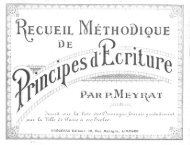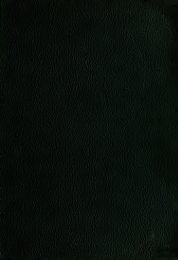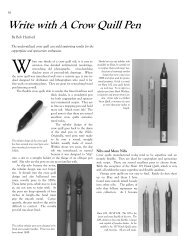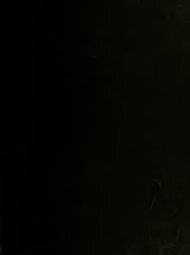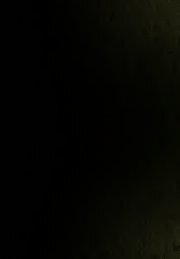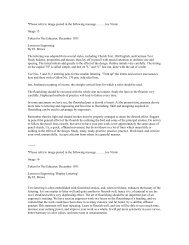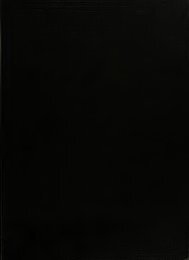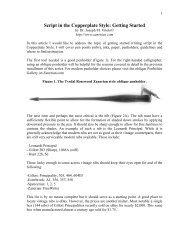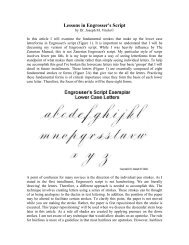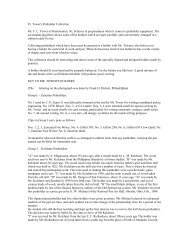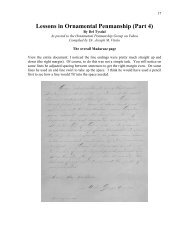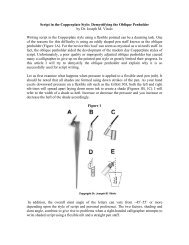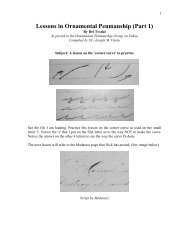The Educator (Volume 45) - IAMPETH
The Educator (Volume 45) - IAMPETH
The Educator (Volume 45) - IAMPETH
You also want an ePaper? Increase the reach of your titles
YUMPU automatically turns print PDFs into web optimized ePapers that Google loves.
to assume an awkward position in<br />
oi'der to see his writing. In planning<br />
schools, the right-handed student is<br />
often considered only. <strong>The</strong> lefthander<br />
is often forgotten.<br />
Where chairs are provided with<br />
arm rests for writing, there should<br />
be some rests on the left side for<br />
the left-handers. Desks should be<br />
arranged so the light is good for<br />
both left and right-handed students.<br />
Where the light is not right for the<br />
left-handers, they may find that<br />
their hands throw shadows on their<br />
work. <strong>The</strong>y, therefore twist their<br />
hands around so that they will not<br />
shade their writing. Poor position<br />
and poor writing is the result.<br />
7. Check Eyesight.<br />
<strong>The</strong> eyesight of every student, especially<br />
the left-hander, should be<br />
checked. If it is discovered that eye<br />
trouble exists, an effort should be<br />
made to correct the trouble and<br />
surely the left-handed student should<br />
be given a desk with the best possible<br />
lighting conditions or he may<br />
develop eye trouble. Some schools<br />
have clinics and give much attention<br />
to the eyesight of students.<br />
8. Much Study and Practice Needed.<br />
Penmanship is a skillful art and re-<br />
<strong>The</strong> <strong>Educator</strong> 21<br />
quires much study and practice.<br />
"Repetition is the secret of improvement."<br />
Surely the left-handed student<br />
should be encouraged to do much<br />
studying and practicing. It is a well<br />
known fact that one who is handicapped<br />
and for some reason is slower<br />
than the average may overcome this<br />
by doing a little extra work.<br />
If you are not getting satisfactory<br />
results, possibly you are not devoting<br />
enough time to practice the drill.<br />
9. Lack of Ability.<br />
<strong>The</strong> percentage of students who<br />
lack ability physically or mentally to<br />
develop into good writers is very<br />
small. This applies to both right and<br />
left-handed students. <strong>The</strong>ir inability<br />
to learn may not be because of<br />
handedness, but because of other reasons.<br />
10. Injurious Influence.<br />
Students are influenced by likes<br />
and dislikes of the teacher. If she<br />
assumes an encouraging attitude, it<br />
will be reflected in the student. If<br />
she writes well, the student will<br />
make an effort to imitate her. One<br />
right-handed student wrote with his<br />
left hand because his first grade<br />
teacher wrote left-handed—a clear<br />
case of imitation.<br />
FROM THE SATURDAY EVE-<br />
NING POST<br />
<strong>The</strong>re recently appeared in the<br />
Post, a story telling how Woolworth,<br />
the executive of 5 and 10 cent stores<br />
in America and England, was attracted<br />
by the fine penmanship of<br />
Samuel H. Belfour, a bookkeeper in<br />
Ogdensburg, New York. Finally, Mr.<br />
Woolworth employed Mr. Belfour,<br />
A LEFT-HANDED WRITER.<br />
Belfour was sent to England as an<br />
executive, but his health failed and<br />
after returning to America, he died,<br />
otherwise, he would have shared in<br />
the wealth of the Woolworth mil-<br />
GOOD WRITING<br />
(Right or Left-handed)<br />
1. Is easily read.<br />
2. Is wi-itten freely and without<br />
much effort.<br />
3. Should be of convenient and<br />
even size.<br />
4. Is regular in slope—preferably<br />
forward.<br />
5. Is neat in arrangement and appearance.<br />
6. Is uniform in thickness of line<br />
—not heavy and clumsy or light and<br />
skippy.<br />
7. Is spaced evenly in words with<br />
enough space between them to make<br />
reading easy—not crowded or scattered.<br />
<strong>The</strong> above is a miscellaneous collection of left-handed specimens which have been received in the past month. A<br />
large number of left-handed specimens come over our desk and these specimens are a fair average of the quality<br />
done by left-handed students. Of course we get some which are not as good and some which are very much better.<br />
<strong>The</strong> first specimen was \viitten by Mary Lee Hogue, fifth grade pupil in the Pennsboro Public Schools, Pennsboro,<br />
West Virginia.<br />
Number 2 and Number 4 were written by W. L. Jarvis, a young man here in Columbus who was in the ofliice the<br />
other day and gave us one of the finest exhibitions of left-handed writing we have ever seen. He writes business<br />
and ornamental penmanship equally well.<br />
Number 3 was written by Annie Pruitt, a student in the Oswego Public Schools, Oswego, Kansas.<br />
Number 5 was written by Eleanor Dodson, first grade pupil.<br />
Number 6 by Helen Hurst, a sixth grade pupil in Pennsboro Public Schools, Pennsboro, West Virginia.<br />
Number 7 is by a left-handed Garbutt Business College student, Doris Jackson.<br />
Number 8 was written by Floyd E. J. Powell, a student in the Beacom College, Wilmington, Delaware.



